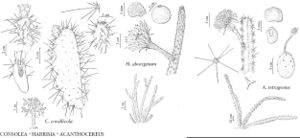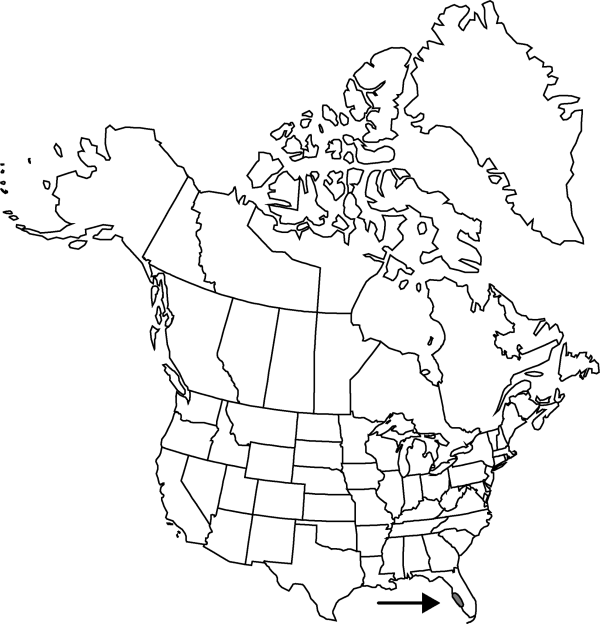Difference between revisions of "Harrisia aboriginum"
Cact. 2: 154. 1920.
Common names: Yellow prickly apple aboriginal prickly apple prickly applecactus
Synonyms: Cereus aboriginum (Small ex Britton & Rose)L ittle Cereus gracilis var. aboriginus (Small ex Britton & Rose) L. D. Benson Harrisia donae-antoniae unknown
FNA>Volume Importer |
FNA>Volume Importer |
||
| Line 12: | Line 12: | ||
|name=Cereus aboriginum | |name=Cereus aboriginum | ||
|authority=(Small ex Britton & Rose)L ittle | |authority=(Small ex Britton & Rose)L ittle | ||
| − | }}{{Treatment/ID/Synonym | + | }} {{Treatment/ID/Synonym |
|name=Cereus gracilis var. aboriginus | |name=Cereus gracilis var. aboriginus | ||
|authority=(Small ex Britton & Rose) L. D. Benson | |authority=(Small ex Britton & Rose) L. D. Benson | ||
| − | }}{{Treatment/ID/Synonym | + | }} {{Treatment/ID/Synonym |
|name=Harrisia donae-antoniae | |name=Harrisia donae-antoniae | ||
|authority=unknown | |authority=unknown | ||
| Line 34: | Line 34: | ||
|distribution=Fla. | |distribution=Fla. | ||
|discussion=<p>Of conservation concern.</p><!-- | |discussion=<p>Of conservation concern.</p><!-- | ||
| − | --><p>According to D. F. Austin (1984), Harrisia aboriginum and H. simpsonii are weakly separated, differing primarily in fruit color, which remains yellow in H. aboriginum while turns to red at maturity in H. simpsonii.</p><!-- | + | --><p>According to D. F. Austin (1984), <i>Harrisia aboriginum</i> and <i>H. simpsonii</i> are weakly separated, differing primarily in fruit color, which remains yellow in <i>H. aboriginum</i> while turns to red at maturity in <i>H. simpsonii</i>.</p><!-- |
| − | --><p>Harrisia aboriginum has been found on pre-Columbian, aboriginal shell mounds, hence the specific epithet.</p> | + | --><p><i>Harrisia aboriginum</i> has been found on pre-Columbian, aboriginal shell mounds, hence the specific epithet.</p> |
|tables= | |tables= | ||
|references= | |references= | ||
| Line 59: | Line 59: | ||
|publication year=1920 | |publication year=1920 | ||
|special status= | |special status= | ||
| − | |source xml=https://jpend@bitbucket.org/aafc-mbb/fna-data-curation.git/src/ | + | |source xml=https://jpend@bitbucket.org/aafc-mbb/fna-data-curation.git/src/8f726806613d60c220dc4493de13607dd3150896/coarse_grained_fna_xml/V4/V4_295.xml |
|subfamily=Cactaceae subfam. Cactoideae | |subfamily=Cactaceae subfam. Cactoideae | ||
|genus=Harrisia | |genus=Harrisia | ||
Revision as of 17:27, 18 September 2019
Stems erect to reclining, to 6 m; ribs 9–11. Spines 7–9 per areole, pink when young, becoming brown tipped, to 1 cm. Flowers: flower tube 10–15 cm, smooth or scarcely ridged; scales turgid, with axillary tufts of hairs; hairs tawny brown, stiff, 6–10 mm; buds with brown hairs. Fruits dull yellow at maturity, spheric, 65–75 mm diam.
Phenology: Flowering spring–summer.
Habitat: Coastal hammocks, shell mounds
Elevation: 0 m
Discussion
Of conservation concern.
According to D. F. Austin (1984), Harrisia aboriginum and H. simpsonii are weakly separated, differing primarily in fruit color, which remains yellow in H. aboriginum while turns to red at maturity in H. simpsonii.
Harrisia aboriginum has been found on pre-Columbian, aboriginal shell mounds, hence the specific epithet.
Selected References
None.
Lower Taxa
None.

